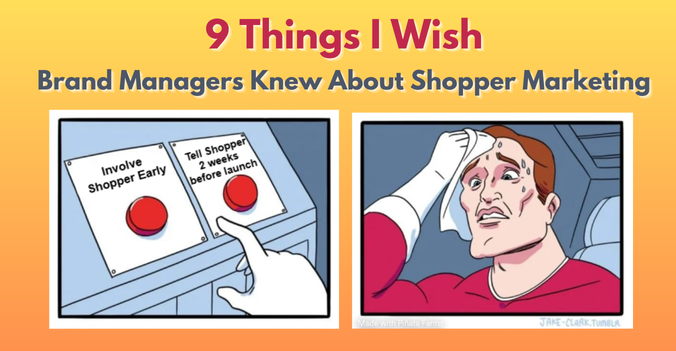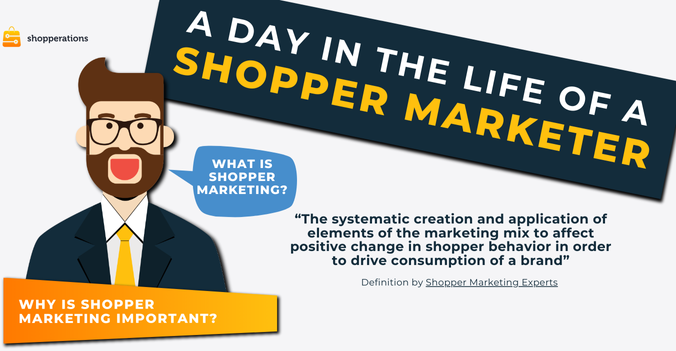.png?width=460&name=How%20to%20recognize%20and%20manage%20shopper%20marketing%20scope%20creep%20(1).png) Despite the promise of automation and greater employee productivity, our jobs seem to stress us out more than ever. Shopper marketing professionals, for many reasons, are affected with productivity and scope management stress more than any other corporate marketing function. If your and your team’s calendars are constantly double- or even triple-booked, the scope of work keeps creeping up, and work-life balance suffers as a result, let’s brush up on the good old Pareto Principle, or 80/20 rule, and explore ways to dramatically increase your team’s efficiency without burning out.
Despite the promise of automation and greater employee productivity, our jobs seem to stress us out more than ever. Shopper marketing professionals, for many reasons, are affected with productivity and scope management stress more than any other corporate marketing function. If your and your team’s calendars are constantly double- or even triple-booked, the scope of work keeps creeping up, and work-life balance suffers as a result, let’s brush up on the good old Pareto Principle, or 80/20 rule, and explore ways to dramatically increase your team’s efficiency without burning out.
What’s Causing Shopper Marketing Scope Creep?
One reason your team may be over-extended is because your team has achieved great success and gained credibility. Now more brands and retail-facing teams want to partner with you. If that’s the case, congratulations, you will likely get approval for a headcount increase to resolve this bottleneck.
However, a far more common reason why many shopper marketing teams suffer from scope creep is that the function was not set up as a strategic capability from the very beginning. Instead, shopper marketers often serve as a “catch all” for all emerging or hard to label marketing activities. Acting more like a marketing services department, there is no vision and strategic focus, making it hard to judge the value of the work that is sent their way, and they hesitate to say “no.”
How to Apply Pareto Principle to Shopper Marketing Scope Creep
1. Track your team’s activities:
Do you feel as if your workload is increasing or do you have data to substantiate the increase? Have a way of filtering all incoming requests by setting a very simple work request forms (a free Google Form will do). Track who, why, what and when work needs done. While this type of filter is unlikely to stop the flow of work, this process will provide you you with statistics and insight into what is actually going on with your team’s time. While your current project trackers and budget reports may be a good start, we find that a lot of shopper marketers’ activities are not captured in them, especially if they are funded by other team’s budgets.
2. Analyze the impact of your work:
Are you working on big, ground-breaking ideas — or at least on those that can be replicated more than once within one retail account or easily scaled to others? Or are you simply responding to ad-hoc requests from your matrix partners, trying to please everyone around?
Order-taker mentality may be a comfortable status quo, but it robs you and your team of the control of their time and puts them into reactive mode, constantly chasing other people’s priorities and deadlines. The best way to take charge is to link all requests for your team’s time to incremental sales impact. It’s important to do it both before the project start and as part of post-event analysis to validate the original assumptions and refine for future requests. If your team’s capacity is limited and post-event sales validation seems like a distant dream, start with upfront-only sales forecasting. It is better than not tracking and attributing time to sales impact at all because this simple step ensures discipline of thought and creates a natural pause to reflect on the value of work before the work begins.
3. Make tough choices:
Not all brands and customers are created equal. While it’s tempting to think you’re a superhero who can fulfill every single request, you have to focus on sustainability and employee satisfaction, free up time to strategize and think big, try new things and learn new skills.
Here is where 80/20 rule comes into play. It may not be exactly 80/20, but you need to determine the number of brands that drive the bulk of your product portfolio’s volume and a cut-off threshold for key accounts that truly deserve robust joint business planning process, in-person sell-in, and customized shopper solutions. This exercise will likely be painful, even controversial, however the solid data you collected earlier, and the rational, strategic approach to prioritization will help your team eventually thrive and become a better partner to your matrix counterparts.
4. Templatize, outsource or automate the rest:
Now that you’ve picked your key priorities, seek ways to take the rest of the scope off your plate. Understand industry best practices and employee productivity benchmarks to make a case for why your 3-person team can’t reasonably and efficiently handle 40 retail accounts or 25 brands’ demands. Look for marketing services companies to outsource small account support, templetize and automate the marketing materials order processing. Thankfully, there are solutions in place to templatize your sales and marketing collateral, automate coupon offer creation and digitally customize point-of-sale materials in a seamless automated interface your company’s sales reps can handle themselves.

"At my previous job, when we saw shopper marketing project requests from small regional customersincreasing over the years, we partnered with Tukaiz to automate the POS ordering process. This allowed us to focus more time and resources on serving large national accounts, I only wish we did this sooner. Looking back, I realize that this was a bold move that required us to be strategic. In order to templatize and outsource small account support, we had to clearly define our priority seasons and occasions, develop a limited number of promotional idea platforms, focus on the most appropriate and scalable tactics and clearly define the collateral ordering process, all of which required a tremendous discipline of thought and sense of purpose." - Leslie Lee, Director of Shopper Engagement at Hormel Foods
Saving time, staying sane and feeling fulfilled by doing meaningful work are not the only benefits you will achieve if you strategically apply the Pareto Principle to your shopper marketing workload. By focusing on the most important priorities and establishing a team culture where all activities drive incremental revenue, you will build professional credibility that will help you secure incremental resources, be it headcount or budgets.




.png)

.png)



